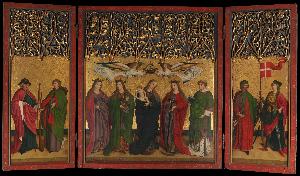Master Of The Burg Weiler Altarpiece
Master Of The Burg Weiler Altarpiece
Place: Swabia
Biography:
The Enigmatic Master of the Burg Weiler Altarpiece: Unveiling the Mysteries of a 15th-Century German Painter Introduction In the realm of art, there exist enigmatic figures who have left an indelible mark on the canvas of history. One such figure is the Master of the Burg Weiler Altarpiece, a German painter active in Swabia during the 15th century. This article delves into the life and works of this mysterious artist, exploring his contributions to the world of art. The Triptych: A Masterpiece of Middle Rhenish Style Master Of The Burg Weiler Altarpiece, named after the triptych originally from the castle chapel in Weiler, near Heilbronn, now resides in the Cloisters collection of the Metropolitan Museum of Art. Dated to around 1470, this masterpiece is a quintessential example of North Württemberg (now Baden-Württemberg) artistry in the Middle Rhenish style. Artistic Contributions and Style The Master's work is characterized by: - Serenity and Devotion: His paintings often exude a sense of serenity, reflecting the artist's deep devotion to his craft.
- Mastery of Color and Composition: The use of vibrant colors and meticulous composition showcases the Master's skill in balancing aesthetics with narrative.
- Influence on Later Artists: Though the Master's influence is not well-documented, his style can be seen in various works from the Middle Rhenish period.
Notable Works and Collections - Triptych of the Burg Weiler Altarpiece (c. 1470, Cloisters collection of the Metropolitan Museum of Art, New York) - Jan Van Eyck's Diptych (56 x 19 cm, Metropolitan Museum of Art, New York), a comparative piece showcasing the artist's contemporaries. Legacy and Impact The Master of the Burg Weiler Altarpiece has left an enduring legacy in the world of art. His works continue to inspire artists and art enthusiasts alike, offering a glimpse into the artistic landscape of 15th-century Germany. - Explore more about Master Of The Burg Weiler Altarpiece on Wikioo.org.
- Discover the Mosan Art Movement, a style that influenced many artists of this period.
The Triptych: A Masterpiece of Middle Rhenish Style Master Of The Burg Weiler Altarpiece, named after the triptych originally from the castle chapel in Weiler, near Heilbronn, now resides in the Cloisters collection of the Metropolitan Museum of Art. Dated to around 1470, this masterpiece is a quintessential example of North Württemberg (now Baden-Württemberg) artistry in the Middle Rhenish style. Artistic Contributions and Style The Master's work is characterized by: - Serenity and Devotion: His paintings often exude a sense of serenity, reflecting the artist's deep devotion to his craft.
- Mastery of Color and Composition: The use of vibrant colors and meticulous composition showcases the Master's skill in balancing aesthetics with narrative.
- Influence on Later Artists: Though the Master's influence is not well-documented, his style can be seen in various works from the Middle Rhenish period.
Notable Works and Collections - Triptych of the Burg Weiler Altarpiece (c. 1470, Cloisters collection of the Metropolitan Museum of Art, New York) - Jan Van Eyck's Diptych (56 x 19 cm, Metropolitan Museum of Art, New York), a comparative piece showcasing the artist's contemporaries. Legacy and Impact The Master of the Burg Weiler Altarpiece has left an enduring legacy in the world of art. His works continue to inspire artists and art enthusiasts alike, offering a glimpse into the artistic landscape of 15th-century Germany. - Explore more about Master Of The Burg Weiler Altarpiece on Wikioo.org.
- Discover the Mosan Art Movement, a style that influenced many artists of this period.
- Serenity and Devotion: His paintings often exude a sense of serenity, reflecting the artist's deep devotion to his craft.
- Mastery of Color and Composition: The use of vibrant colors and meticulous composition showcases the Master's skill in balancing aesthetics with narrative.
- Influence on Later Artists: Though the Master's influence is not well-documented, his style can be seen in various works from the Middle Rhenish period.
Notable Works and Collections - Triptych of the Burg Weiler Altarpiece (c. 1470, Cloisters collection of the Metropolitan Museum of Art, New York) - Jan Van Eyck's Diptych (56 x 19 cm, Metropolitan Museum of Art, New York), a comparative piece showcasing the artist's contemporaries. Legacy and Impact The Master of the Burg Weiler Altarpiece has left an enduring legacy in the world of art. His works continue to inspire artists and art enthusiasts alike, offering a glimpse into the artistic landscape of 15th-century Germany. - Explore more about Master Of The Burg Weiler Altarpiece on Wikioo.org.
- Discover the Mosan Art Movement, a style that influenced many artists of this period.
- Explore more about Master Of The Burg Weiler Altarpiece on Wikioo.org.
- Discover the Mosan Art Movement, a style that influenced many artists of this period.

